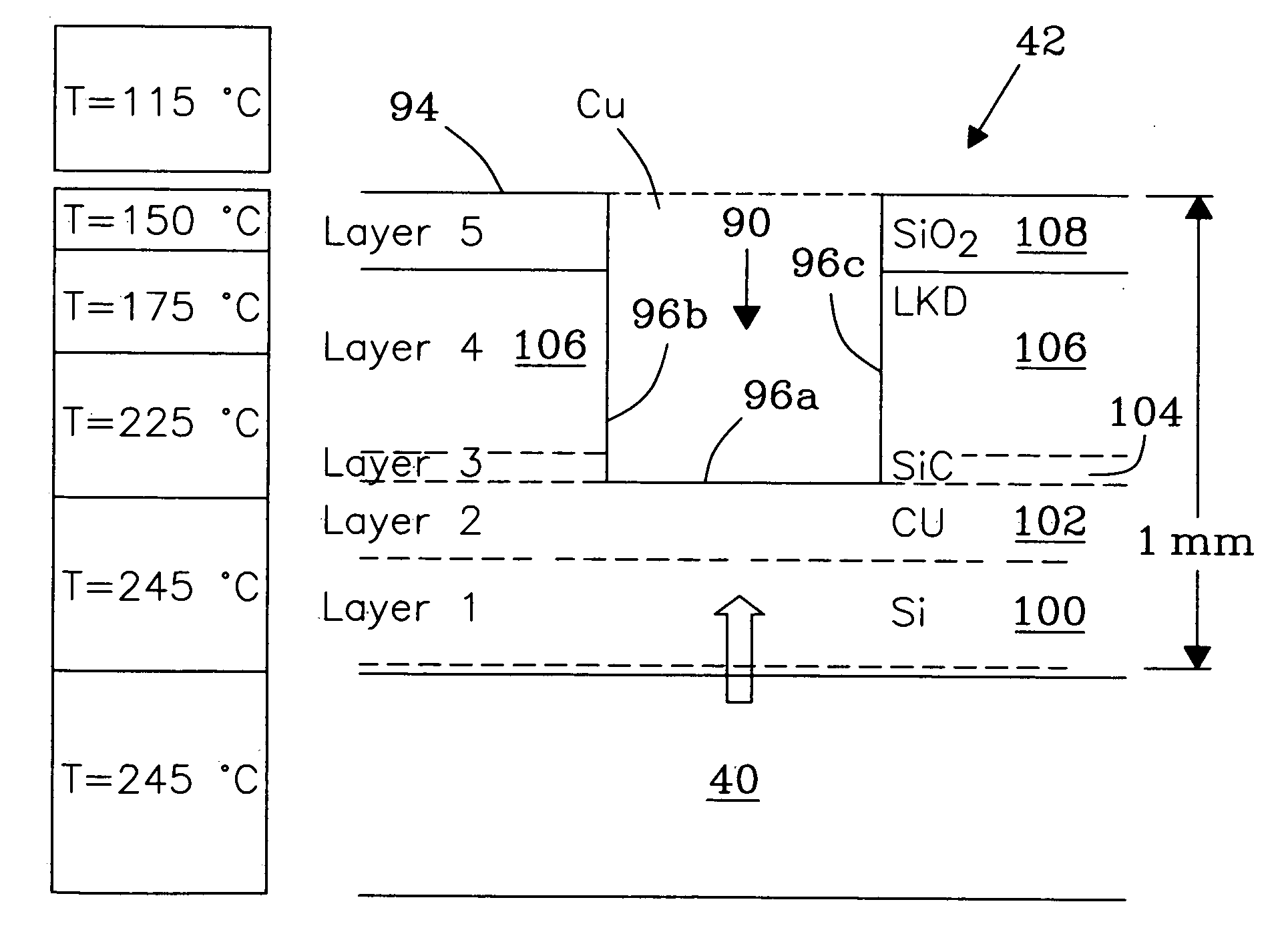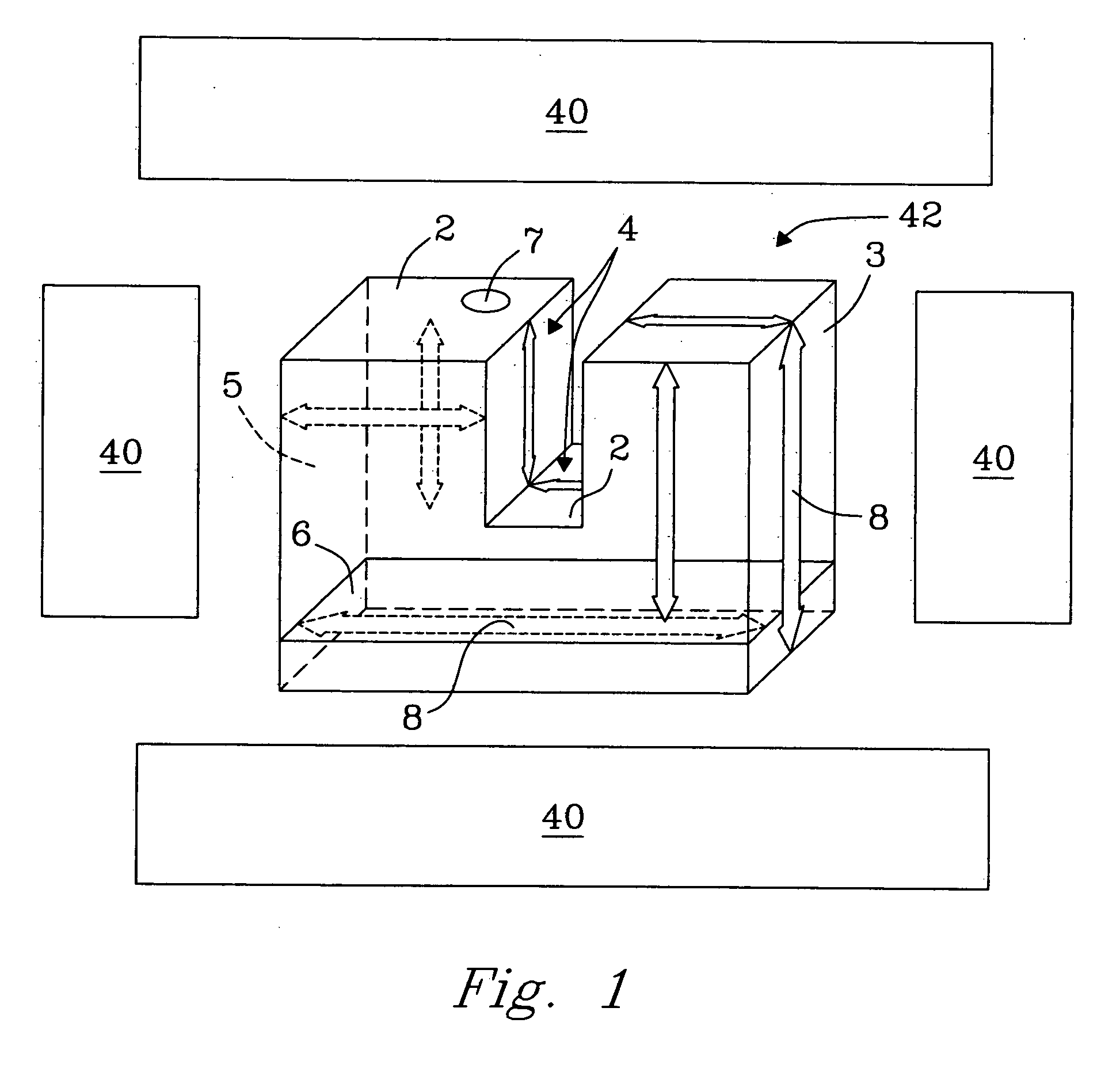Method and apparatus for selective deposition of materials to surfaces and substrates
a technology of material deposition and surface, applied in the direction of liquid/solution decomposition chemical coating, chemical vapor deposition coating, coating, etc., can solve the problems of insufficient deposition of materials, and inability to achieve efficient, optimal, and/or proper deposition of materials
- Summary
- Abstract
- Description
- Claims
- Application Information
AI Technical Summary
Benefits of technology
Problems solved by technology
Method used
Image
Examples
example 1
[0057] Ruthenium is a promising electrode material in G-bit-scale dynamic random access memories (DRAMs) given its low resistivity, excellent chemical stability and good dry etching properties. In an example of the invention illustrated in FIG. 6, ruthenium metal was selectively deposited in vias 90 (pattern features) of a semiconductor chip substrate 42 filling vias 90. The system involves a solvent fluid 59 comprising densified carbon dioxide, a ruthenium metal precursor, Ru3(CO)12, stable at liquid, near-critical or supercritical temperatures for the solvent fluid, and a stoichiometric excess of a reagent gas, e.g., H2, preventing undesired oxidation reactions in the deposition vessel. Elemental ruthenium (Ru°) released from precursor 58 at or above the decomposition temperature for precursor 58 was deposited to substrate 42 selectively filling pattern vias 90. Substrate 42 was sized by scoring and breaking along the crystal planes, yielding a coupon of about 1 in. to 1.75 in. on...
example 2
[0060] In a further example of the invention illustrated in FIG. 8, copper metal was selectively deposited in the vias 90 (pattern features) of a semiconductor chip substrate 42 selectively filling the vias 90. The system comprises a solvent fluid 59 of densified carbon dioxide, a copper metal precursor 58, e.g., copper (II) hexafluoroacetylacetonate [Cu(hfac)2] (Sigma-Aldrich, Milwaukee, Wis.), and a stoichiometric excess of a reagent gas (H2). Copper (Cu+2) is released from precursor 58 to the deposition surface(s) of the vias 90 and reduced by the H2 reagent selectively filling the vias 90. Substrate 42 had dimensions of about 1 in. to 1.75 in. on a side. Vias 90 had a horizontal length dimension of 1 μm and a depth of ˜200 nm.
[0061] Experimental. 25 mg of solid precursor, e.g., Cu(hfac)2, was weighed into vessel 12 and placed underneath stage 38 in chamber 82. A semiconductor chip substrate 42 as described in Example 1 was secured to ceramic heating stage 38. Vessel 12 was seal...
example 3
[0063] In another example of selective deposition illustrated in FIG. 9, ruthenium metal was selectively deposited in vias 90 of a semiconductor chip substrate 42 partially coating the vias 90 along a temperature gradient generated therein. A ruthenium metal precursor, Ru3(CO)12, and a stoichiometric excess of a reagent gas, e.g., H2, that prevents undesirable oxidation from miscellaneous oxygen sources in the reaction chamber during deposition, were mixed in a solvent fluid 59 of densified CO2. A temperature gradient was generated in the vias 90 in conjunction with a heating source 40 such that elemental ruthenium (Ru°) released from precursor 58 (e.g., above the release temperature for the precursor 58) was selectively deposited to surfaces within the vias 90 where temperature was above the release temperature for the precursor 58 thereby coating vias 90 along the temperature gradient. Substrate coupons 42 were sized by scoring and breaking along the crystal planes yielding a coup...
PUM
| Property | Measurement | Unit |
|---|---|---|
| Depth | aaaaa | aaaaa |
| Depth | aaaaa | aaaaa |
| Depth | aaaaa | aaaaa |
Abstract
Description
Claims
Application Information
 Login to View More
Login to View More - R&D
- Intellectual Property
- Life Sciences
- Materials
- Tech Scout
- Unparalleled Data Quality
- Higher Quality Content
- 60% Fewer Hallucinations
Browse by: Latest US Patents, China's latest patents, Technical Efficacy Thesaurus, Application Domain, Technology Topic, Popular Technical Reports.
© 2025 PatSnap. All rights reserved.Legal|Privacy policy|Modern Slavery Act Transparency Statement|Sitemap|About US| Contact US: help@patsnap.com



